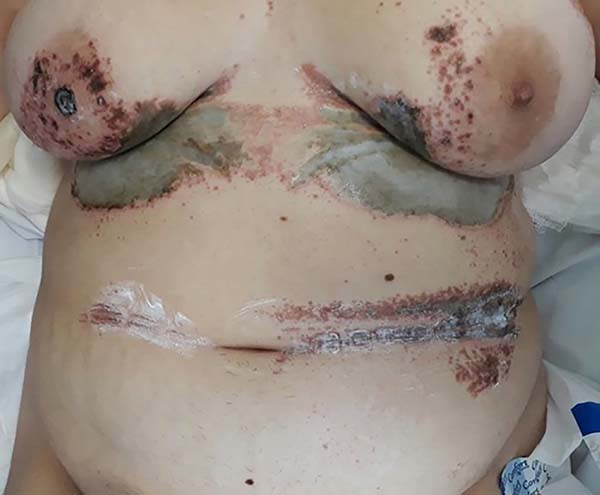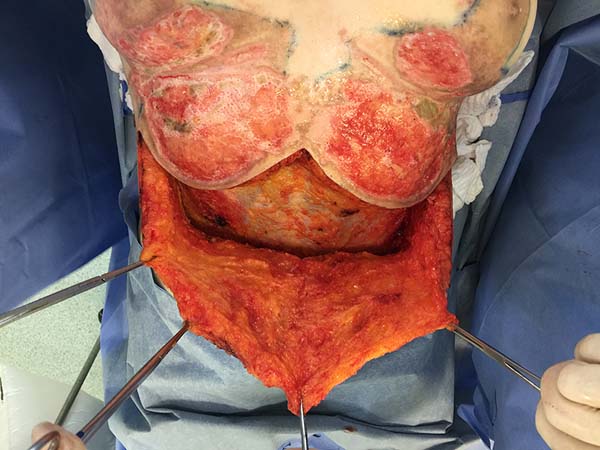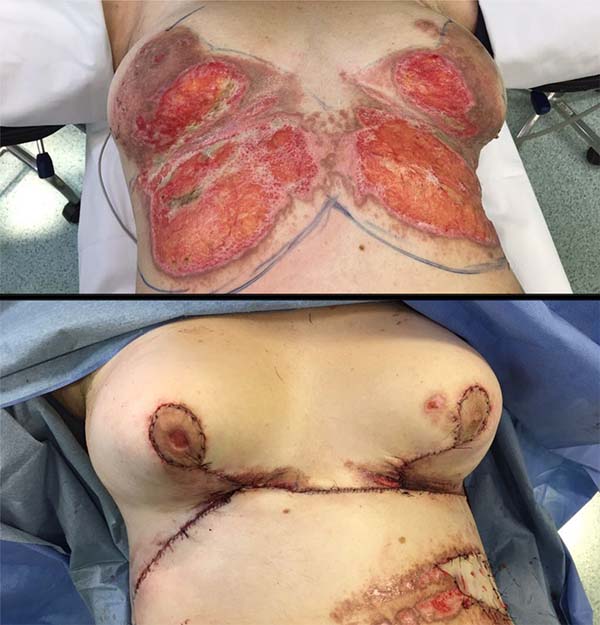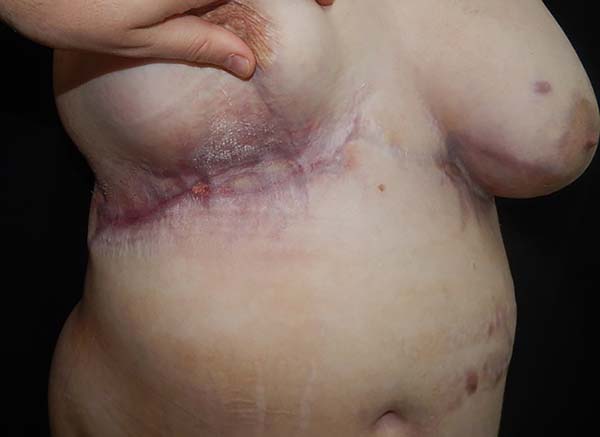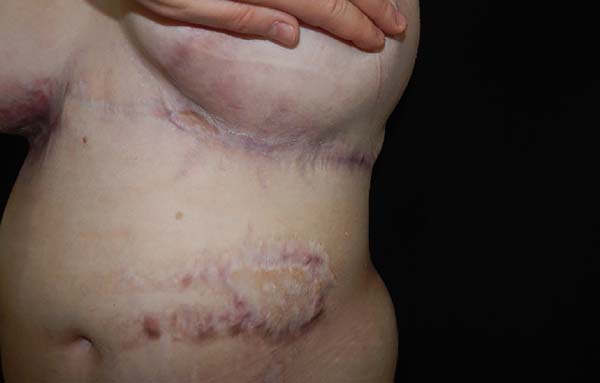INTRODUCTION
Chemical burns account for 4 to 5% of total burns, 25% of which are caused by an alkaline
agent. Fifty percent of chemical burns are associated with accidents in the workplace,
30% are related to domestic accidents and 20% are caused by aggression1. Chemical injuries are more likely to be deeper owing to prolonged exposure to the
agent in contrast to thermal injuries, which generally have shorter exposure to intense
heat.
Third degree burns are treated by early tangential debridement and dressings, followed
by skin grafting or flaps depending on the affected area, for better results2. However, complications and deformities such as infections, contractures, and graft
hyperpigmentation3 can make the treatment and prognosis of an extensive chemical burn a challenge. Currently,
the different strategies to minimize these complications is actively being researched
and supported, such as the use of topical heparin in burns4 and studies on the use of flaps, which have proven promising5.
Reverse abdominoplasty is a procedure developed in 1972 with the purpose of aesthetic
resection of skin excesses located in the epigastrium, which causes a single scar
line in the inframammary groove. Later, the extended reverse abdominoplasty was developed
with the purpose of aesthetic improvement to the entire anterior wall of the abdomen,
with ample dissection to the pubis6.
Using these concepts, surgery with a reparative concept was proposed for a burn case
in the thoracoabdominal region of a patient with excess skin, minimizing healing time,
hospitalization, and procedures needed for completion of the treatment.
CASE REPORT
A 33-year-old woman, Caucasian and primigravida, who suffered a burn by a chemical
product (sodium hydroxide, “caustic soda”) in thoracoabdominal region. On examination,
she presented second degree superficial burns in the anterior region of the face,
as well as in the back, both breasts, abdomen, and perineal. The deep second degree
burns were located in the posterior cervical region, inframammary, and upper abdomen,
totaling approximately 14% of the burned body surface (Figure 1). No history of smoking or alcoholism was indicated.
Figure 1 - Chemical burn in the thoracoabdominal region.
Figure 1 - Chemical burn in the thoracoabdominal region.
The initial appointment was based on ATLS protocols. It was performed using the emergency
hydrotherapy and four-layer dressing. In the first days of admission, surgical tangential
debridement to the devitalized tissues and dressings with chemical debridement were
performed to prepare the wound for definitive treatment.
After improvement of the burn injuries, resection of all burned tissues was performed,
followed by supraumbilical detachment of the abdominal flap (Figure 2). The flap was advanced, followed by plane suturing. The operative preparation involved
all routine measures, including thromboembolic prophylaxis.
Figure 2 - Reverse abdominoplasty flap.
Figure 2 - Reverse abdominoplasty flap.
The most severe lesions were found in locations where the chemical agent remained
in greater contact with the skin because of impregnation on the clothes, which were
in the posterior cervical, inframammary, and upper abdomen regions. After the first
debridement, a necrosis process was observed requiring a second complementary procedure.
After the definitive procedure (mammoplasty with reverse abdominoplasty and abdominal
grafting of small areas), the patient recovered with slight dehiscence of bilateral
inframammary suture on the 10th postoperative day (PO), and she was treated in the ambulatory with chemical debridement
until complete epithelialization. We obtained reduced scars and with a pleasant appearance
in the long term (Figures 3, 4, 5 and 6).
Figure 3 - Immediate postoperative.
Figure 3 - Immediate postoperative.
Figure 4 - Final appearance after a year.
Figure 4 - Final appearance after a year.
Figure 5 - Final appearance after 1 year.
Figure 5 - Final appearance after 1 year.
Figure 6 - Final appearance after 1 year.
Figure 6 - Final appearance after 1 year.
DISCUSSION
Alkaline burns are the second most common category of chemical burns, with sodium
hydroxide (caustic soda) being the most frequent etiological agent in this group.
The mechanism of tissue injury by chemical burning by a basic agent comprises three
factors: 1) intense cell dehydration, 2) saponification of fat (which generates the
loss of the body’s thermal insulation) and 3) inactivation of enzymatic proteins,
which form bonds in parallel with the alkali, giving rise to proteinates in an exothermic
reaction, thereby further aggravating the initial injury7. Alkali burns penetrate deeper into the skin compared to thermal or acid burns. Because
of this great penetration capacity, there is a tendency for the lesions to become
chronic as elimination of the chemical agent is difficult. Thus, there is usually
the need for several tangential debridement until the tissue becomes viable8.
The patient presented with deep lesions caused by the chemical agent and the location
propitiated the reverse abdomen flap. The choice of a definitive treatment (as graft
or flap) should be evaluated on a case-by-case basis.
The surgical choice in this case was due to the severity caused by the chemical burn
because of its extension and depth, in addition to the location of these lesions.
The region is favorable for the reverse abdomen flap (Figure 3). We saw an opportunity to use the reverse abdominal flap as there was excess abdominal
dermis-fat. This option gives aesthetically much better results than partial or total
skin grafting and leaves no additional scars. In contrast, with the flap use, there
is always the risk of necrosis and dehiscence—this did not occur in our case—which
additionally brings the risk of morbidity to the procedure.
Most patients complain about scars and aesthetic quality of grafts after burns. In
this case, if we had opted for graft, in the future, we could correct using the reverse
abdomen. Although the primary goal was not an aesthetically pleasing result, we did
skip a step, and the result was quite satisfactory.
Reverse abdominoplasty is an unusual aesthetic procedure. It has already been proposed
for the reconstruction of chronic scars from previous burns9, however our proposal differs from other cases in the literature because it involves
the reconstruction of the immediate region of the burn, thereby shortening treatment
time and preventing future procedures.
The flap vascularization is maintained by three circulatory systems bilaterally: 1)
perforating branches of the inferior epigastric arteries, as the main cutaneous source,
which emerge from the rectum’s sheath; 2) perforating branches formed by anastomoses
of lumbar arteries, deep circumflex iliac arteries, remnants of intercostal arteries,
and remnants of subcostal arteries, which emerge from the external oblique fascia;
3) superficial inferior epigastric arteries, superficial iliac circumflex arteries,
and superficial external pudendal arteries, originating from the femoral arteries10.
Other types of flaps have already been used for the treatment of a burned patient
with fewer complications; moreover, knowledge of an unusual abdomen flap can help
in the arsenal of burned area coverage, thereby reducing the exposed area and, consequently,
reducing hospitalization time, complications, and number of procedures.
conclusion
Reverse abdominoplasty has recently gained popularity for both aesthetic and reconstructive
purposes. Although unusual, the use of this surgical technique for reconstruction
of thoracoabdominal lesions is feasible and safe because it presents good vascularization
and excellent aesthetic results. It can become an important tool for the plastic surgeon
in the reconstruction of large lesions. In the case of a patient with chemical burns
requiring a significant number of procedures and treatment time, the knowledge of
different flap techniques can contribute effectively in the prognosis of the burn.
COLLABORATIONS
|
GGAT
|
Conception and design study, Conceptualization, Data Curation, Final manuscript approval,
Project Administration, Realization of operations and/or trials
|
|
BOB
|
Analysis and/or data interpretation, Conception and design study, Conceptualization,
Data Curation, Final manuscript approval, Formal Analysis, Funding Acquisition, Investigation,
Methodology, Project Administration, Realization of operations and/or trials, Supervision,
Validation, Visualization, Writing - Original Draft Preparation, Writing - Review
& Editing
|
|
GCT
|
Realization of operations and/or trials
|
|
RBR
|
Realization of operations and/or trials
|
|
RU
|
Realization of operations and/or trials
|
|
ACF
|
Realization of operations and/or trials
|
|
HTR
|
Realization of operations and/or trials
|
REFERENCES
1. Stewart CE. Chemical skin burns. Am Fam Physician. 1985;31(6):149-57.
2. Mélega JM, Viterbo F, Mendes FH. Cirurgia plástica: os princípios e a atualidade.
Rio de Janeiro: Guanabara Koogan; 2011.
3. Teles G, Bastos V, Mello G. Correction of hypercromic palmar graft with split-thickness
instep plantar graft: case report. J Burn Care Res. 2008;29(2):403-5.
4. Teles GGA, Bastos JAV, Amary A, Rufatto LA, Ritty RS, Broglio LAP, et al. Tratamento
de queimadura de segundo grau superficial em face e pescoço com heparina tópica: estudo
comparativo, prospectivo e randomizado. Rev Bras Cir Plást. 2012;27(3):383-86.
5. Lazo DAA, Zatiti SCA, Colicchio O, Roncaglia F, Alvarez DM, Alvarez IM, et al. O emprego
dos retalhos livres em pacientes queimados: experiência de 58 retalhos em 46 pacientes.
Rev Bras Cir Plást. 2009;24(2):138-44.
6. Yacoub CD, Baroudi R, Yacoub MB. Abdominoplastia reversa estendida. Rev Bras Cir Plást.
2012;27(2):328-32.
7. Palao R, Monge I, Ruiz M, Barret JP. Chemical burns: pathophysiology and treatment.
Burns. 2010;36(3):295-304. DOI: https://doi.org/10.1016/j.burns.2009.07.009
8. Lorette Junior JJ, Wilkinson JA. Alkaline chemical burn to the face requiring full-thickness
skin grafting. Ann Emerg Med. 1988;17(7):739-41.
9. Haik J, Grabov-Nardini G, Goldan O, Tessone A, Regev E, Mendes D, et al. Expanded
reverse abdominoplasty for reconstruction of burns in the epigastric region and the
inframammary fold in female patients. J Burn Care Res. 2007;28(6):849-53.
10. Boyd JB, Taylor GI, Corlett R. The vascular territories of the superior epigastric
and deep inferior epigastric systems. Plast Reconstr Surg. 1984;73(1):1-16.
1. Instituto de Cirurgia Plástica Santa Cruz, José Marcos Mélega, Cirurgia Plástica,
São Paulo, SP, Brazil.
Corresponding author: Guilherme Gurgel do Amaral Teles Avenida Jandira, 79, Apto 71, Torre A2, Indianópolis, São Paulo, SP, Brazil. Zip
Code: 04080-007. E-mail: guilhermeteles77@yahoo.com.br
Article received: August 14, 2018.
Article accepted: October 21, 2019.
Conflicts of interest: none.



